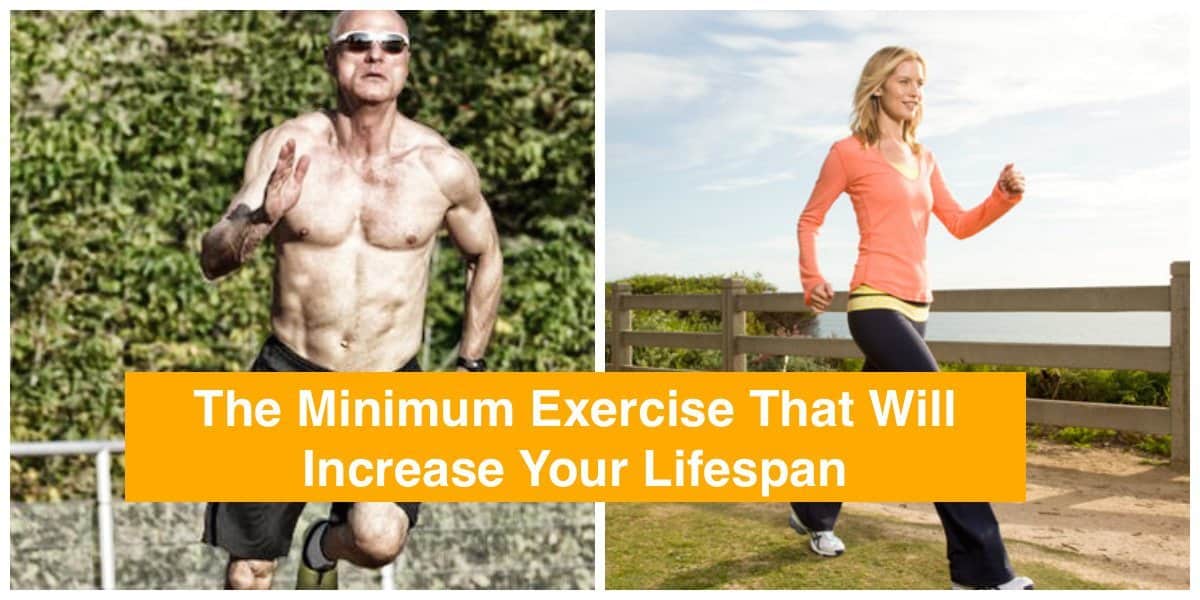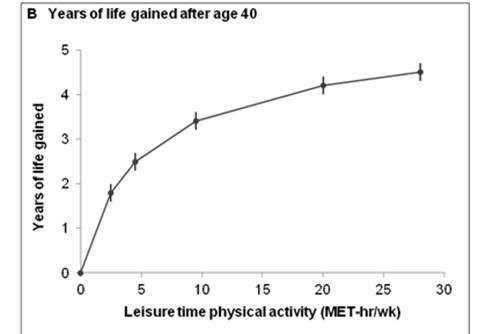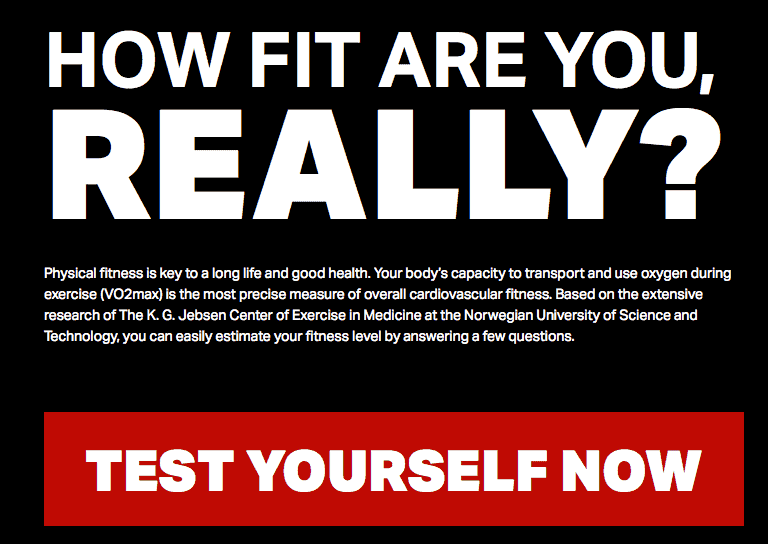The Minimum Exercise That Adds Years To Your Life
Discover the minimum exercise to do to add years to your life and improve your health. Fit people live longer and better, and you can too!
YOU KNOW who you are.
In some ways, each of us is our own greatest mystery, but who we are is made abundantly clear once we lift our heads and look around.
What you’ve created is a clue.
Fat/thin, strong/weak, rich/poor, happy/unhappy, stressed/relaxed, cluttered/Zen – these are states of being that are mostly up to you. Surely, some of us are born into abject circumstances, or fall into them at no fault of our own.
We’re all dealt a particular hand of cards, but how we play them is up to us.
Which is probably more philosophical than I needed to get to make a point about exercise, which is this:
You’re the one who must decide what you want from it, and then “create” the regimen to get the fitness level you want, and sustain it.
Olympic athlete?
Cross fitter?
Weekend warrior?
Walker?
Each offers different outcomes. Each demands different energy inputs. In my own life, my intention is to find the minimum exercise “sweet spot” that will optimize my lifespan AND healthspan.
No one wants a longer life if the added years are to be spent slumped over in a wheel chair drooling on yourself in front of a blaring TV.
Quality of life is the aim!
That’s why I so often mention the importance of “bending the age curve” — to be hale and vigorously pretty much to the day that you lie down and go meet your maker. (See the curve on the homepage.)
In this post:
- What’s the minimum exercise required to increase lifespan.
- How small bursts of exercise can add up to the time constrained.
- Why your exercise “sweet spot” may be easier to attain than you thought.
The good news is that if your objective is to live a long and healthy life, you can achieve that with a minimum of exercise.
Let’s begin with the minimalist approach and then step it up.
-First, we’ll review how you can gain nearly two years of life expectancy by walking briskly for a bit over 10 minutes per day.
-Next, we’ll check out if running improves longevity more than walking.
-Then we’ll take a look at some recent studies about “mirco burst” exercise that can add up to something valuable.
-Finally, we’ll see how much lifespan and healthspan gains are possible by examining participants in the Senior Olympics.
Walk More, Live Longer
A Harvard Gazette article, How much exercise is enough? reviewed research conducted by Brigham and Women’s Hospital (BWH) and the National Cancer Institute that quantified how many years of life are gained by being physically active at different levels, among all individuals, as well as among various groups having different body mass indexes (BMI).
Harvard Medical School Professor of Medicine, I-Min Lee explained:
We found that adding low amounts of physical activity to one’s daily routine, such as 75 minutes of brisk walking per week, was associated with increased longevity: a gain of 1.8 years of life expectancy after age 40, compared with doing no such activity.
Physical activity above this minimal level was associated with additional gains in longevity. For example, walking briskly for at least 450 minutes a week was associated with a gain of 4.5 years. Further, physical activity was associated with greater longevity among persons in all BMI groups: those normal weight, overweight, and obese. (source)
Here’s the graph that tells the tale:
Here’s what the graph indicates regarding lifespan gains after age 40 from walking, (walking intensity was measured by MET, a physiological measure expressing the energy cost of physical activities per hour per week):
- Walk briskly for 75 minutes per week and live 1.8 years longer than if you did no exercise.
- Walk briskly for 150–299 minutes per week (the amount recommended by the U.S. federal government) and live 3.4 years longer than if you did no exercise.
This was observed among persons who were normal weight, overweight, and obese, and of every race. But those who were of normal weight and generally active in their life fared better yet.
Those in this huge study – 650,000 people examined over 10 years – who fared best were of normal weight and active: Their life expectancy gain was 7.2 years, compared with those with a BMI of 35 or more who did no leisure time physical activity. (A 5-foot, 5-inch-tall person with BMI of 35 weighs 210 pounds.)
Conclusion: Everyone who is inactive can benefit from a regular, consistent walking habit.
Exercise A Lot and Live A Lot Longer?
If a little exercise, like walking a little more than ten minutes each day, adds 1.8 years to your life, would walking ten times that amount add 10.8 years?
Not necessarily.
Like with a lot of things, when it comes to exercise and the long-term benefits it provides, there’s a sweet spot. For those of you who want to move faster, let’s step it up the pace up from walking to running. When it comes to running, the sweet spot may be between 51 and 80 minutes per week – the amount that reduces mortality the most — says the Journal of the American College of Cardiology.
This next illustration underscores the concept of diminishing returns when it comes to the amount of exercise related to lifespan, or to put it simpler: More is not better.
Why would people who run 10 to 15 minutes per day have the lowest death rate among runners?
Turns out that there’s a sweet spot for longevity when it comes to running, and most likely with other forms of exercise. As you might expect, the exercise sweet spot is where the least exercise output yields the greatest lifespan and healthspan gains.
In an article called Run for your life… at a comfortable speed and not too far, authors James H. O’keefe and Carl J. Lavie present compelling evidence that runners can maximize their longevity by committing themselves to three specific metrics of distance, speed and frequency:
- Distance — Running between 5 and 20 miles total per week yields the greatest decline in risk of death, 25%.
- Speed — Those who ran between 6 and 7 miles per hour garnered the greatest mortality decline.
- Frequency — Survival advantages accrued best for those who ran 2 to 5 days per week.
These outcomes are borne out by “The Copenhagen City Heart Study”, which found that:
- Joggers lived about 6 years longer than the non-runners, with a 44% lower risk of death, but
- Those who jogged at a slow to average pace, for 1 to 2.5 hours in total during two to three sessions per week.
Conclusion: Jogging will yield better lifespan benefits than walking, but only if done at a moderate speed, distance and frequency.
Micro Burst Exercise for the Sedentary
Can little bits of exercise — some minimum exercise amount — add up to some big benefit? The science and data attempting to answer that query has been changing.
It remains true that you can replace one 40-minute exercise session with two 20-minute ones, or four 10-minute sessions and achieve roughly the same health benefits.
But what about exercise lasting less than 10 minutes? Is it worth anything? We used to think that it didn’t but new studies rebuke that notion.
Alex Hutchinson, a blogger at SweatScience.com, reports that recent studies hold that “incidental physical activity” that may last just one minute, such as stepping up stairs and sweeping the floor, can contribute to cardiovascular fitness.
When I read that I thought, “Sure if you’re 100 pounds overweight and doing that one minute activity makes your heart pound enough to strengthen, but not over tax it.”
Turns out that I was right regarding that particular study, but no so much so in light of the conclusions on Tabata and High Intensity Interval Training.
As I presumed, in the case of overweight and sedentary folk, all they have to do to get started down the path of a longer, healthier life is to accumulate a tiny amount of activity each day.
In a Canadian study, those who totaled 34 minutes per day of moderate activity in just one-minute intervals had a 13% reduction in risk of death from all causes and a 15% reduction in risk of heart disease as compared to the least active group.
None of the study participants met the 10-minute threshold for exercise, nor was their activity “exercise” at all (but rather deemed “activity”), and yet their health and longevity improved.
Conclusion: Exercise lasting less 10 minutes may result in fitness and health benefits, particularly in sedentary, overweight people.
Micro Burst Exercise for the Ambitious
If sweeping the floor for exercise is about as interesting as watching paint dry, you have other short-duration, micro-burst options.
This is about Tabata and High Intensity Interval Training (“HIIT”), which are two sides of the same coin because they both involve doing an exercise activity intensely for a short burst of time, followed by rest, then repeat.
You can apply this “on/off” cycle to just about any exercise that uses large, multiple muscles and can be done both fast and slow. Jog/sprint/jog (then repeat) is a fine example.
The Tabata Protocol is an interval training method based on the research of Izumi Tabata. His original 1996 study monitored athletes as they cycled at their absolute highest intensity for 20 seconds, followed by 10 seconds of rest. This was repeated in various sets, each set consisting of a burst and rest period.
HIIT is very similar; franky, I’m unsure of how it’s different conceptually. I’ve written about HIIT expert, Dr. Phil Campbell instructing Dr. Joseph Mercola on what Dr. Campbell’s research indicates is the ideal HIIT regime:
- 30 seconds full throttle
- 90 seconds active rest
- Repeat 8 times
(Read about this in my article, Boost Your Human Growth Hormone in 20 Minutes! Yes, HIIT does that too.)
My HIIT training is done primarily on set of evenly spaced stairs. I began doing it about three years ago, and still have a hard time going all out for eight sets. You need to be in shape to go all out eight times, but all you have to be to get started is healthy enough not to drop dead from the exertion.
If you want to save time, get fit and boost your human growth hormone, explore HIIT and/or Tabata. The research of Martin Gibala, Chairman of the Department of Kinesiology at McMaster University in Hamilton, Ontario has examined how HIIT sessions can stimulate similar fitness levels as moderate-intensity continuous training. He says:
There’s a very large growing body showing interval training can be safely applied to many different people, including those with chronic diseases.
Interval training can be scaled to any starting level of fitness. If you have a high level of fitness, the speed on the treadmill will be different from someone less conditioned”—but the benefit will be similar.
Conclusion: To do HIIT, your motivation is more important than your fitness level, but if unfit, get a pass from your doctor.
What’s Your “Sweet Spot”?

The lead runners turn a corner through the Cleveland Metroparks Zoo during the National Senior Games’ 5K road race in 2013. Credit Tracey Joyce
All this brings me to a New York Times article written by Gretchen Reynolds entitled, Older Athletes Have a Strikingly Young Fitness Age. Her article says it all, because it really strikes to the heart of the matter, and the mission of this web site.
And that is to nurture the belief that it’s possible to drive down your biological age beneath your chronological age, and then help inspire the right actions to make it happen.
We’re talking a difference of 20 years or more!
Perhaps on any given day the most you move is from your…
- bed to your car
- car to office chair
- chair to car
- car to couch
- couch to bed
If that’s the case, it’s likely that you’re either overweight or unfit, or both. That’s OK, cause, as my mother likes to say on a daily basis,
“It is what it is”.
Wherever you’re at, that’s where you begin. Scoot on up to “Walk More, Live Longer” and get inspired to walk every day. If you can’t muster that, amble on up to “Micro Burst Exercise for the Sedentary” and find ways that you can do at least 35 one minute activities each day that are one-minute long.
Either the walking or the one-minute activities will pay you dividends as above described.
After you start feeling real good, and want to do more, join those readers who will go right to “Micro Burst Exercise for the Ambitious”. Spending some time in this realm is going to make you rich. Your richness will be in the form of functional age that may become 20 years less than your years on the planet.
Science says it’s true.
Ms. Reynolds wrote that a new study showed older athletes could be much younger, physically, than they really are. The study found that the athletes’ fitness age is typically 20 years or more younger than their chronological age.
Anyone would sign up to that, but few do. I think it’s for two reasons:
- It’s not believable, and/or
- The price is too high.
That said, I think the price is too high mainly do to the believable part. If you cold be totally convinced that devoting yourself to consistent, progressive exercise, and a clean, superfood dominant diet (etc.) could make you feel at 50 how you did at 30, wouldn’t you pay the price?
Norwegian University of Science and Technology is at the cutting edge of research about how cardiovascular fitness relates to healthy aging and longevity. They have the epidemiological data that prove people with above-average cardiovascular fitness typically have longer life spans than people with lower aerobic fitness.
Translation: Fit people are relatively younger than unfit people. And this is true for any given age.
In an endeavor to give folks a sense for their fitness level relative to their chronological age, the good Norwegian scientist types developed a simple online calculator that people like your very own self could use to determine their fitness age.
When 4,200 men and women who were Senior Olympic qualifiers took the online test, their results were jaw-dropping:
- Average chronological age of those tested — 68
- Average fitness age — 43
- Difference: They were 25 years younger!
What’s even more surprising than those results — and so important to anyone who has never exercised regularly — most participants in the Senior Olympics did not began training regularly until they were middle aged or older.
Conclusion: Begin getting younger at any age by getting fitter.
Your Takeaway
Let’s distill this article down to three points that you can ruminate upon at your leisure:
- If you’re inactive and unmotivated, walk regularly or divide your activity into at least 35 one-minute flutters of movement — the so-called “micro bursts”.
- No matter your fitness, if you’re motivated begin with whatever exercise you’re willing to sustain consistently, and progress to more challenging regimes, such as HIIT.
- Whatever you do, don’t over due it. More is not necessarily mo better — you need to strike that balance (find that sweet spot) between the level of exertion that will degrade the body over time and that which will make it stronger and live longer.
That’s a wrap.
Please share this with friends and family… especially since the best way to begin and sustain an exercise program is to recruit a friend to join you.
Last Updated on April 23, 2021 by Joe Garma






